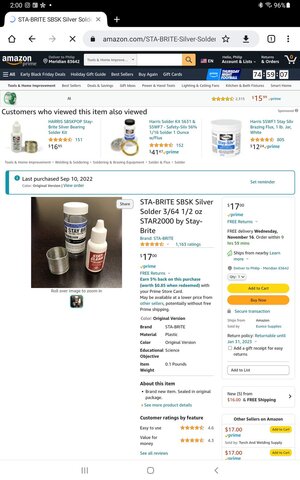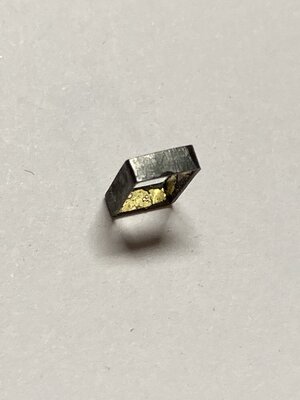I'm about to buy some silver solder paste. What is best for most of the stuff we do, hard, medium or soft? I have a torch, so heat is not a problem.
You are using an out of date browser. It may not display this or other websites correctly.
You should upgrade or use an alternative browser.
You should upgrade or use an alternative browser.
Soft solder uses less heat and if probably easier to work with, the same as lead solder. We don't need the strength of hard solder in modeling.
Thanks Kurt. You say, "is probably". Is that what you use?
I solder things with softer, flux core solder. It's not nearly as strong, but it works for models. There are very few things outside of electrical lighting connections that benefit from solder joints on older ship, but the chainplates is definitely one of them.Thanks Kurt. You say, "is probably". Is that what you use?
I believe there is a practical aspect to using different "hardnesses" of solder - melt and flow temperatures. Hard solder has higher melt and flow temperatures than medium which is higher than soft solder. This can prove useful when you need to solder several components in some sort of order. Using a solder with higher melt & flow temperature for the first parts and then a solder with lower melt & flow temperatures for the next piece prevents the first solder joint(s) from melting while soldering the next piece.
I picked this up from watching videos of jewelry making when trying to improve my soldering skills. I am not certain how useful this information is to ship modelling, however.
I picked this up from watching videos of jewelry making when trying to improve my soldering skills. I am not certain how useful this information is to ship modelling, however.
I have silver solder rods and flux, but I want to try the paste. I think that I could get a lot less solder on the joint that way. I'm going to be soldering the chain plates, so I was concerned about the strength. I'm not sure if soft silver solder would be that much stronger than soft(plumbers) solder.
There sure is a lot of confusing terms in soldering. There is soft solder that is lead(not any more) based. And silver solder in soft, medium and hard. So soft solder could be silver or lead based. Then there is paste which can be solder and flux mixed or just flux. It's a hard thing to talk about.
There sure is a lot of confusing terms in soldering. There is soft solder that is lead(not any more) based. And silver solder in soft, medium and hard. So soft solder could be silver or lead based. Then there is paste which can be solder and flux mixed or just flux. It's a hard thing to talk about.
I use this paste. Paste is very easy to use.

 www.fdjtool.com
www.fdjtool.com

SPSXE10 = Silver Paste Solder Extra Easy 1/2oz (10dwt) Syringe by FDJtool
SPSXE10 = Silver Paste Solder Extra Easy 1/2oz (10dwt) Syringe
- Joined
- Nov 1, 2022
- Messages
- 48
- Points
- 93

Hello,
To make welded joints I always use 40% silver solder.
For small assemblies I file solder rods and I collect the filings obtained.
I apply the liquid stripper flux to the joint to be brazed and I put some filings on it. All that remains is to heat the assembly and the solder will go to the right place by capillarity.
It is necessary to put just the bare minimum of material to obtain a good solder.
To obtain a good result, the assemblies must be perfectly adjusted.
Try it, it's worth it.
To make welded joints I always use 40% silver solder.
For small assemblies I file solder rods and I collect the filings obtained.
I apply the liquid stripper flux to the joint to be brazed and I put some filings on it. All that remains is to heat the assembly and the solder will go to the right place by capillarity.
It is necessary to put just the bare minimum of material to obtain a good solder.
To obtain a good result, the assemblies must be perfectly adjusted.
Try it, it's worth it.
I thought of doing this but I was thinking of using a sander and I couldn't come up with a way of collecting the powder. A file may be the answer to that. Slower, but probably better. Thanks.Hello,
To make welded joints I always use 40% silver solder.
For small assemblies I file solder rods and I collect the filings obtained.
I apply the liquid stripper flux to the joint to be brazed and I put some filings on it. All that remains is to heat the assembly and the solder will go to the right place by capillarity.
It is necessary to put just the bare minimum of material to obtain a good solder.
To obtain a good result, the assemblies must be perfectly adjusted.
Try it, it's worth it.
I haven't looked yet but I think that jewellry making sites may be the place to go.
Here is a video with silver solder paste and additional silver solder for thermally highly stressed components.
In model making, there will be no getting around soldering at some point.
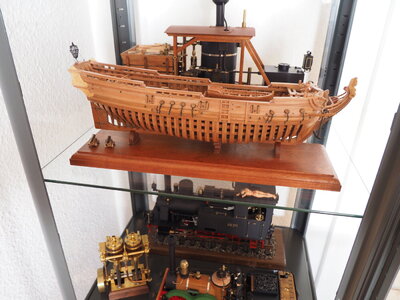
"La Belle" was made with soft solder and hard solder. The live steam models that are also standing are mainly hard soldered, because they would fall apart with soft solder during operation.
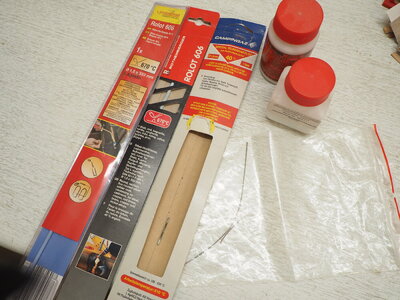
Silver solder with working temperature from 595 degrees Celsius.
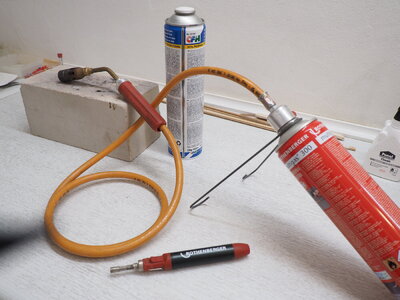
Minimum requirements for a hard solder station.
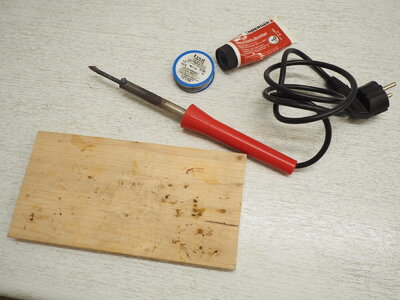
Soft soldering does not look so "dangerous".
For both soldering methods, the components must be metallically clean (without oxidation and grease). After hard soldering, place the finished parts in vinegar for about 1 hour to clean them. Soft soldered components are cleaned with water. This removes the flux residues. Flux residues that are not removed will otherwise destroy the components over a longer period of time. The temperatur difference between the two soldering methods of several 100 degrees during processing is fundamental. The more beautiful seams and durability results from hard soldering, but there is a risk that photoetched components can simply melt away.
I have always been afraid of soldering, but since a few years and practise it is very easy. Try it with scrap pieces. You will achieve excellent results after a little time.
Keep your spouse and pets away from it and make sure it is safe.
Best regards
Thomas
In model making, there will be no getting around soldering at some point.

"La Belle" was made with soft solder and hard solder. The live steam models that are also standing are mainly hard soldered, because they would fall apart with soft solder during operation.

Silver solder with working temperature from 595 degrees Celsius.

Minimum requirements for a hard solder station.

Soft soldering does not look so "dangerous".
For both soldering methods, the components must be metallically clean (without oxidation and grease). After hard soldering, place the finished parts in vinegar for about 1 hour to clean them. Soft soldered components are cleaned with water. This removes the flux residues. Flux residues that are not removed will otherwise destroy the components over a longer period of time. The temperatur difference between the two soldering methods of several 100 degrees during processing is fundamental. The more beautiful seams and durability results from hard soldering, but there is a risk that photoetched components can simply melt away.
I have always been afraid of soldering, but since a few years and practise it is very easy. Try it with scrap pieces. You will achieve excellent results after a little time.
Keep your spouse and pets away from it and make sure it is safe.
Best regards
Thomas
Last edited:
- Joined
- Nov 1, 2022
- Messages
- 48
- Points
- 93

Hello,
Here are two sets of photos about how to make a small brass part.
It is true that the solder exists in syringe and ready to use, but having 40% silver solder rods I developed this method to avoid unnecessary expense because these syringes are still quite expensive .


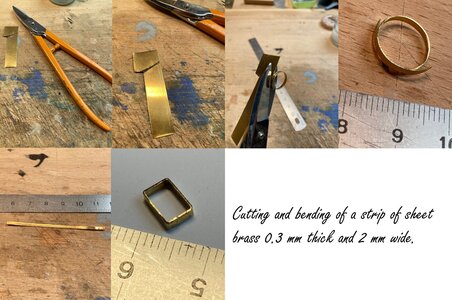 View attachment 341048
View attachment 341048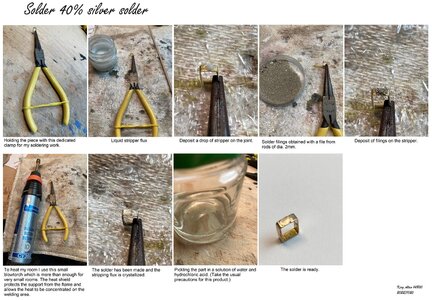
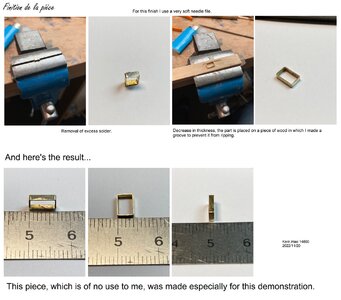
For example, a slightly more complex part that I made with the same process for a tail wheel of a De Havilland Tiger Moth model airplane. (stainless steel and brass)
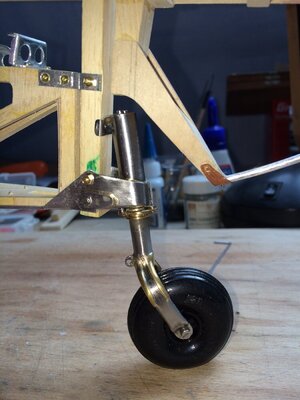
Here are two sets of photos about how to make a small brass part.
It is true that the solder exists in syringe and ready to use, but having 40% silver solder rods I developed this method to avoid unnecessary expense because these syringes are still quite expensive .


 View attachment 341048
View attachment 341048

For example, a slightly more complex part that I made with the same process for a tail wheel of a De Havilland Tiger Moth model airplane. (stainless steel and brass)

Last edited:
Good stuff! A related question, does silver solder blacken better than soft solder?
- Joined
- Nov 1, 2022
- Messages
- 48
- Points
- 93

Hello Don!
Silver solder alloyed with copper and brass when soldering and can be colored much better than soldering with soft solder.
Best regards
Thomas
Silver solder alloyed with copper and brass when soldering and can be colored much better than soldering with soft solder.
Best regards
Thomas
Last edited:
Hi Thomas, you put some great infos here, So thanks. However, I have difficulty to read the yellow inscriptions on your pictures, Could you just put the writing below in order of pics presentation, so we will be able to read it better ?
Thanks in advance,
Michel
Thanks in advance,
Michel
Hi Fish&Chip!
You must mean the clues in the pictures of Kerz Atao F14800. If he read this, I'm sure he will provide clarification.
Best regards
Thomas
You must mean the clues in the pictures of Kerz Atao F14800. If he read this, I'm sure he will provide clarification.
Best regards
Thomas
I am sorry, Thomas, you are right. It is my mistake, but I did not change my mind about of the great value of your input.
Thanks,
Michel
Thanks,
Michel




